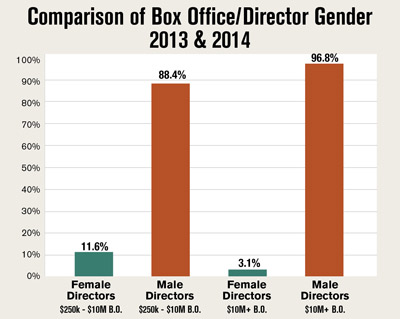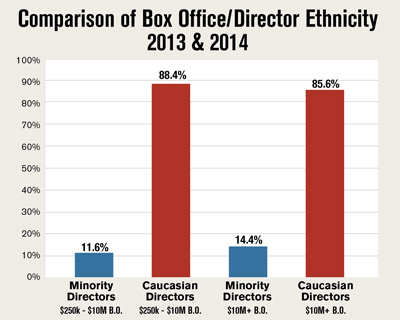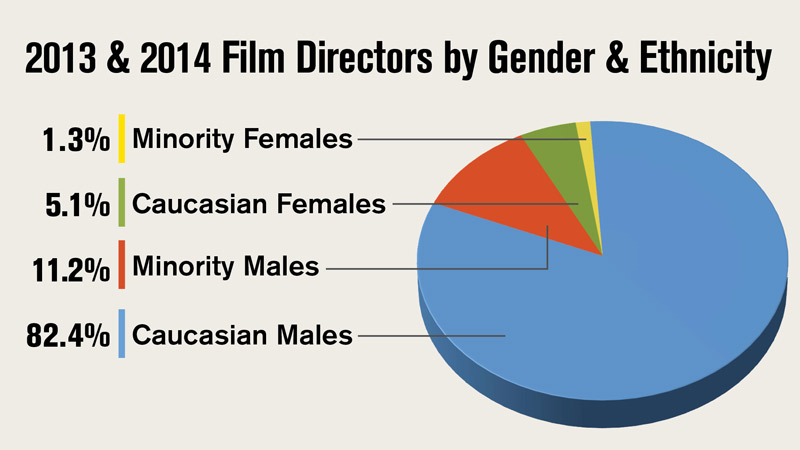December 9, 2015
LOS ANGELES – The Directors Guild of America (DGA) today released its inaugural Feature Film Diversity Report analyzing the gender and ethnicity of feature film directors. Of the 376 [1] directors of features released in 2013 and 2014, just 6.4% were women and just 12.5% were minority directors. A further breakdown by gender and ethnicity follows:
- Caucasian males: 82.4%;
- Minority males: 11.2%;
- Caucasian females: 5.1%; and
- Minority females: 1.3%
“What this report does not reflect is what people who love film – even our culture as a whole – are missing when such a disproportionate percentage of films are directed by one gender or one ethnicity. Unfortunately, we don’t have a metric for that.” said DGA President Paris Barclay. “What you will see is what happens when industry employers – studios and production companies – do little to address this issue head on. The DGA, by detailing the state of director hiring with the precision of our data, hopes to draw further attention to this serious matter so that industry employers can develop concrete director diversity plans.”
To best serve as a representation of the industry and account for inconsistencies in a single production or distribution cycle, this first report is a two-year study analyzing the films that were released in 2013 and 2014 [2]. The report does not include foreign films, documentaries, animated films and re-releases. The 347 features studied were produced by companies (which range from the major studios and their subsidiaries to smaller production companies) that are signatory to the DGA’s collective bargaining agreement – together, they accounted for approximately 97% percent of the total domestic live-action box office.[3] While not the focus of the study, the DGA also analyzed films produced by companies that are not signatory to DGA’s collective bargaining agreement and found that hiring of women directors followed a similar pattern in both groups.
Comparison by Box Office
The DGA conducted further analysis to better understand whether barriers grew for women and ethnically diverse directors as the size of a project increased. In the absence of publicly available data on the budgets for each of the features covered in the report, the DGA studied the percentage of women and minority directors based on a film’s box office [4] – a key indicator of project size, number of theatrical screens and studio marketing support. Titles were divided into two categories: 1) those with a box office between $250k and $10 million, a range which generally represents lower budget and/or independent films that had national releases, and 2) those with a box office greater than $10 million, generally representing films that had significant commercial releases and larger budgets. The findings suggest that women face significant barriers to employment as directors of high-budget, wide-release projects.

Gender
The DGA found that there was a considerable drop-off in the percentage of women directors for films that earned more than $10 million. Of the 86 directors of 69 films which earned a box office between $250k and $10 million, 11.6% were women. Of the 222 directors of 212 films that had a box office greater than $10 million, just 3.1% were women.

Ethnicity
When comparing the percentage of ethnically diverse directors based on a film’s box office, the DGA did not find a significant difference between the two box office groups. The percentage of minority directors increased in the higher box office category. Of the 86 directors of 69 films that earned a box office between $250k and $10 million, 11.6% were minority directors. Of the 222 directors of 212 films that had a box office greater than $10 million, 14.4% were minority directors.
Films Released By Major and Mini-Major Studios
When taking a closer look at directors of films distributed by the dominant employers in the industry – major studios (including their subsidiaries), and “mini-major” studios – only 3.8% were women and 13.6% were minority directors.
“The numbers paint a grim outlook for diverse film directors – women in particular,” said DGA Diversity Task Force Co-Chair Bethany Rooney. “Much like our recent reports on television director diversity, we hope this report will put a magnifying glass on a system that makes it disproportionately challenging for talented women and minority film directors to get hired.”
 238 Films | 263 Directors
238 Films | 263 Directors
DIRECTOR GENDER & ETHNICITY
Films Distributed by Major Studios (including subsidiaries)
and Mini-Major Studios
Major Studios
|
Studios
|
No. Films
|
No. Dir.
|
Male
|
Female
|
Male Caucasian
|
Female Caucasian
|
Male Minority
|
Female Minority
|
|
20th Century Fox[a]
|
32
|
32
|
94%
|
6%
|
78%
|
3%
|
16%
|
3%
|
|
Disney
|
16
|
18
|
100%
|
0%
|
94%
|
0%
|
6%
|
0%
|
|
Paramount
|
21
|
21
|
95%
|
5%
|
86%
|
0%
|
10%
|
5%
|
|
Sony [b]
|
36
|
41
|
98%
|
2%
|
80%
|
2%
|
17%
|
0%
|
|
Universal [c]
|
34
|
35
|
94%
|
6%
|
83%
|
6%
|
11%
|
0%
|
|
Warner Bros.
|
37
|
38
|
100%
|
0%
|
89%
|
0%
|
11%
|
0%
|
[a] Includes Fox Searchlight ↩
[b] Includes Sony Pictures Classics ↩
[c] Includes Focus Features ↩
Mini-Major Studios
|
Studios
|
No. Films
|
No. Dir.
|
Male
|
Female
|
Male Caucasian
|
Female Caucasian
|
Male Minority
|
Female Minority
|
|
Lionsgate
|
21
|
22
|
91%
|
9%
|
59%
|
5%
|
32%
|
5%
|
|
Open Road
|
10
|
10
|
100%
|
0%
|
100%
|
0%
|
0%
|
0%
|
|
Relativity Media
|
4
|
16
|
94%
|
6%
|
88%
|
6%
|
6%
|
0%
|
|
Summit
|
10
|
11
|
91%
|
9%
|
91%
|
9%
|
0%
|
0%
|
|
The Weinstein Co.
|
17
|
19
|
100%
|
0%
|
89%
|
0%
|
11%
|
0%
|
“The numbers indicate that women and minority directors are virtually shut out of this multi-billion dollar industry that has a deep financial and cultural impact on our global society. In order to make progress, the film studios need to take this information and commit to becoming real agents of change with solutions,” said DGA Diversity Task Force Co-Chair Todd Holland.
| |
Films Produced By Companies That Were Not Signatory
To DGA’s Collective Bargaining Agreement
To further investigate the prevalence of hiring patterns revealed in this report, the DGA also examined films produced by companies that were not signatory to the DGA’s agreement. This much smaller group of titles reflected the same general pattern with respect to women directors. The findings follow: of the 32 directors of 32 non-DGA films which earned between $250,000 and $10 million at the box office, four (12.5%) were women. Of the 17 directors of 13 non-DGA films which earned more than $10 million at the box office, none (0%) were women. The DGA was not able to identify minority directors of non-DGA films due to incomplete publicly available information.
|
DGA Diversity Efforts
At the DGA, we believe storytelling should be as diverse as the world around us, and that a critical mass of different perspectives on screen is vital for the wellbeing and development of society. We’re committed to realizing the vision of a diverse and inclusive industry, and have worked toward this goal for decades.
Although the DGA has no authority over director hiring, we seek to wield our influence and utilize our collective bargaining power, relationships and resources to try to change industry practices. Currently, we employ a four-pronged approach to advance the issue: (1) engage with industry decision-makers; (2) negotiate with employers; (3) develop networking, career enhancement and training opportunities; and (4) report back to the industry.
For more information about the DGA’s diversity efforts, CLICK HERE.
[1] A small number of films are directed by a co-directing team of two, accounting for the difference between the number of films and the number of directors. ↩
[2] Films that opened and earned any reported domestic box office in 2013 and 2014 produced by a company or entity covered under a DGA Agreement. The DGA compiled the statistics for this report from multiple sources including: an internal database proprietary to the DGA; information provided by production companies pursuant to the requirements of DGA’s collective bargaining agreement; and third-party sources. The report does not include foreign films, documentaries, animated films and re-releases. ↩
[3] DGA films in this study represent 97% of total domestic, live action, play period box office for films released in 2013 and 2014. ↩
[4] Titles that were released in the U.S. in 2013 and 2014 that earned domestic play period box office of $250,000 or more. “Play Period” box office as reported by Rentrak and Box Office Mojo. ↩